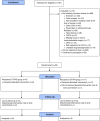Brief Vigorous Stair Climbing Effectively Improves Cardiorespiratory Fitness in Patients With Coronary Artery Disease: A Randomized Trial
- PMID: 33665614
- PMCID: PMC7921461
- DOI: 10.3389/fspor.2021.630912
Brief Vigorous Stair Climbing Effectively Improves Cardiorespiratory Fitness in Patients With Coronary Artery Disease: A Randomized Trial
Abstract
Background: Cardiac rehabilitation exercise reduces the risk of secondary cardiovascular disease. Interval training is a time-efficient alternative to traditional cardiac rehabilitation exercise and stair climbing is an accessible means. We aimed to assess the effectiveness of a high-intensity interval stair climbing intervention on improving cardiorespiratory fitness ( ) compared to standard cardiac rehabilitation care. Methods: Twenty participants with coronary artery disease (61 ± 7 years, 18 males, two females) were randomly assigned to either traditional moderate-intensity exercise (TRAD) or high-intensity interval stair climbing (STAIR). was assessed at baseline, following 4 weeks of six supervised exercise sessions and after 8 weeks of ~24 unsupervised exercise sessions. TRAD involved a minimum of 30 min at 60-80%HRpeak, and STAIR consisted of three bouts of six flights of 12 stairs at a self-selected vigorous intensity (~90 s/bout) separated by recovery periods of walking (~90 s). This study was registered as a clinical trial at clinicaltrials.gov (NCT03235674). Results: Two participants could not complete the trial due to the time commitment of the testing visits, leaving n = 9 in each group who completed the interventions without any adverse events. increased after supervised and unsupervised training in comparison to baseline for both TRAD [baseline: 22.9 ± 2.5, 4 weeks (supervised): 25.3 ± 4.4, and 12 weeks (unsupervised): 26.5 ± 4.8 mL/kg/min] and STAIR [baseline: 21.4 ± 4.5, 4 weeks (supervised): 23.4 ± 5.6, and 12 weeks (unsupervised): 25 ± 6.2 mL/kg/min; p (time) = 0.03]. During the first 4 weeks of training (supervised) the STAIR vs. TRAD group had a higher %HRpeak (101 ± 1 vs. 89 ± 1%; p ≤ 0.001), across a shorter total exercise time (7.1 ± 0.1 vs. 36.7 ± 1.1 min; p = 0.009). During the subsequent 8 weeks of unsupervised training, %HRpeak was not different (87 ± 8 vs. 96 ± 8%; p = 0.055, mean ± SD) between groups, however, the STAIR group continued to exercise for less time per session (10.0 ± 3.2 vs. 24.2 ± 17.0 min; p = 0.036). Conclusions: Both brief, vigorous stair climbing, and traditional moderate-intensity exercise are effective in increasing , in cardiac rehabilitation exercise programmes.
Keywords: cardiac rehabilitation; cardiorespiratory fitness; coronary artery disease; exercise; high intensity interval training.
Copyright © 2021 Dunford, Valentino, Dubberley, Oikawa, McGlory, Lonn, Jung, Gibala, Phillips and MacDonald.
Conflict of interest statement
The authors declare no professional relationships with companies or manufacturers who will benefit from the results of the present study. The results of the present study do not constitute endorsement by ACSM. The authors declare that the results of the study are presented clearly, honestly, and without fabrication, falsification, or inappropriate data manipulation.
Figures



References
Publication types
Associated data
LinkOut - more resources
Full Text Sources
Other Literature Sources
Medical

